Peak: Pico de Orizaba aka Citlaltepetl (18,490′, Eje Volcánico Transversal Range)
Route: Orizaba’s Jamapa Glacier
Partner: Stuart Clark
Date Climbed: December 31, 2007
Day 5: Tlachichuca to Piedra Grande
Stu and I climbed out of the taxi into the cultured alleys of Tlachichuca around 4pm on December 29, 2007. Stu handed the driver three thousand pesos and he was on his way, leaving the two of us to our own devices in yet another unfamiliar Mexican town. We had not spoken a lick of English to anyone except each other for five days now, and our money was running out.
“We should really try to find a ride to Piedra Grande tonight so we don‘t need to pay for another hotel room”, said Stu.
“I agree.”
Stu and I carried one hundred and twenty pounds of clothing and mountaineering gear on our shoulders, and we made a point to never let it out of our sight. We dropped our bags on the curb to consider our options, a donkey toting a hay cart plodded past.
“Give me a radio and I‘ll try to find a ride, we need to leave soon as its getting dark”, I said.
“Great I’ll just wait here!”
Stu and I had just arrived via taxi from Amecameca, a small town thirty miles east of Mexico City where we stayed for four days to make our bid at Iztaccihuatl, Mexico‘s third highest peak. We had come up a little short however, reluctantly turning back 500’ below the summit due to AMS. Like many others who visit the Mexican Volcanoes, we had never experienced altitudes higher than 14,400‘ and our arrogance concerning the matter cost us the summit.
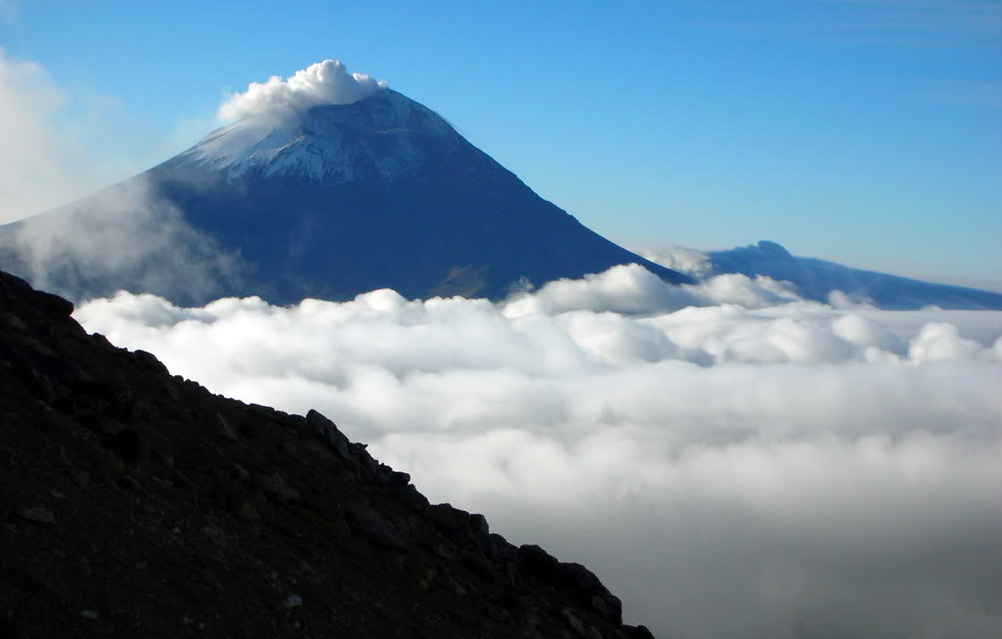
Taken from 16,000 on Ixta earlier in the trip.
Now, two days later we found ourselves craning up at the summit of Orizaba two vertical miles above, dwelling on the fact that we would need to achieve an altitude 2000’ higher than our turn around point on Iztaccihuatl. Needless to say we were apprehensive but we came to Mexico to climb mountains and we sure weren‘t leaving without giving Orizaba a go.
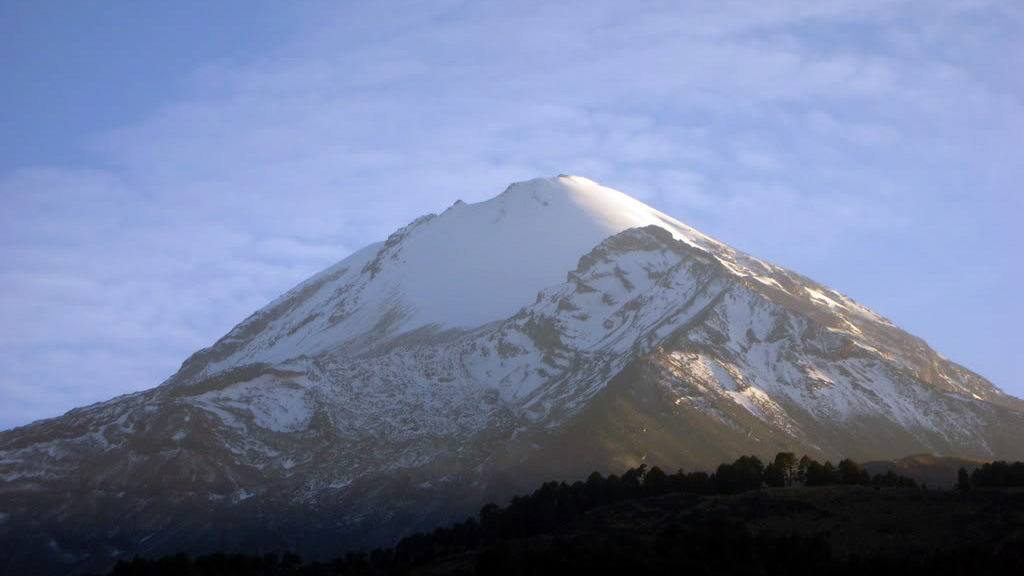
Pico de Orizaba from just outside Tlachichuca.
Stu handed me a radio and I split off into the streets of Tlachichuca. We often would separate to buy food and find lodging in order to avoid lugging our gear into crowded areas. Stu would lie low with the gear while I performed the task at hand, we could communicate via radio if necessary. I plodded into numerous restaurants and shops, forming skeletons of Spanish sentences which almost always sufficed to get me what I wanted. The radio let out a beep followed by Stu‘s voice.
“There‘s a guy here who seems to be offering me a ride in his jeep.”
“I‘ll be right there.”
I hurried back to find Stu scratching his head in response to the rapid firing of a weathered Mexican man named Felipe. It didn‘t take long to discern that he was offering us dinner and a ride to Piedra Grande; apparently he recognized that we were climbers, as well as a source of income for him. We agreed to pay him fifteen hundred pesos for dinner, two canisters of fuel, and transportation to base camp.
Felipe was very generous; we stayed in his quaint home for over an hour, eating an excellent chicken tortilla and beans dinner prepared by his wife. An aerial photo of Orizaba hung on the wall in the dining room. Shortly after dinner, we stopped by the market to stock up on three days of food (primarily canned tuna and bread), refueled the Jeep, and started our drive into the mountains.
The four wheel drive road to Piedra Grande snakes up through vast canyons and valleys, sculpted by the drained glacial waters of the Eje Volcánico Transversal Mountains. The road winds around the base of Orizaba to the north, gradually gaining altitude, and ends at the concrete huts of Piedra Grande. We bounced along in Felipe’s rickety Jeep, the sun gradually setting to the west cast a beautiful alpenglow on the upper ramparts of the Jamapa Glacier a mile and half above us. We pulled into Piedra Grande at six in the evening and made arrangements to be picked up forty eight hours later. Felipe promptly departed, he would have to drive back in the dark as the sun had almost completely disappeared.
“Well this is it, we have forty eight hours to acclimatize and get this bastard”, I said.
“Yeah let’s do it right this time.”
We decided to settle on the top bunk of the larger hut which happened to be fifteen feet off the ground. The hut contained at least twenty people of all different nationalities broken into about three teams. Each team seemed to have their own set of cooking gear and supplies which were massed together on one central table in the middle of the hut. Each team would approach Orizaba their own way; at least two of the groups would leave at 3:00 am the following morning for the summit, having acclimated for multiple days at 13,900’, the elevation of Piedra Grande. We later found that there were two other groups who had established a high camp at 16,000’ and were planning a summit assault from there, having acclimated for one night at a higher altitude.
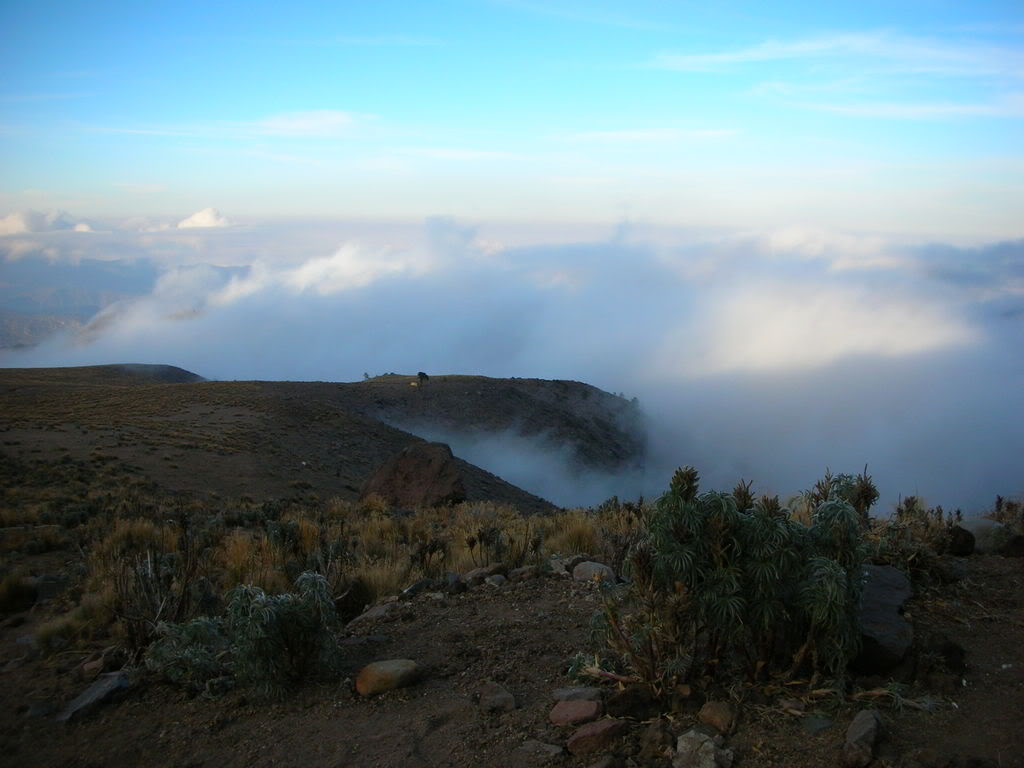
Near camp at 14,000 ft.
Stu and I thought it best to sleep for two nights at Piedra Grande with an acclimation hike to 16,200‘ before the second night, and then go for the summit from the base on morning of the third day. Stu organized our gear and I stepped outside for a short walk, intending to find an English-speaking group. Twenty yards from the hut I found a group of three from Nova Scotia who had been turned back two hundred feet from the summit earlier in the day. Two of them had been caught in a blizzard on the Jamapa Glacier in the early afternoon and were almost blown off the mountain, the third turned back because of AMS. They also told me about a girl who fell halfway up the mountain and had to be rescued and hauled out the day before.
I returned to the hut to find several people preparing for a climb the following morning. Once inside, I found a guide who spoke broken English. He told me that his clients all turned back due to AMS at the base of the glacier. I climbed to the top of the hut to find Stu cooking and reading Dostoevsky. Shortly after sharing the others’ experiences with him, we fell asleep. We were as apprehensive as ever about the climb.
Day 6: Acclimation Day
I awoke at first light and immediately felt very hungry, a good sign that my acclimation was going well. I did not sleep well however, at 14,000’ good sleep is a bit difficult to come by, especially in a 30 person hut. The hut was nearly empty; most of the climbers were a third of the way up the mountain. Stu awoke a short time later and we scarfed down on bread and tuna. Because the importance of acclimation had been rigorously instilled in us by this point, we resolved to drink five liters of water per day for our entire stay at altitude in order to avoid a repeat of what happened on Iztaccihuatl; because of this we would take several hikes to a natural spring to pump water over the following day and a half.
Around noon, we packed small backpacks of gear and water and headed off for our acclimation hike. We worked our way up through a thousand vertical feet of rock moraines, skirting around cliff bands and hopping through boulder fields. A little higher we strapped on our crampons and donned our axes; the terrain quickly turned to snow and ice and the grade steepened a bit.
The middle segment of Orizaba (from 15,000’ to 16,500’ or so) consists of a maze of house-sized boulders and cliff bands covered in snow, this section is referred to as “The Labyrinth”. In certain areas the slope exceeds forty five degrees but never for more than fifty feet. Once through this section we gained a ridge and plopped down on a rock outcropping to make some hot tea. This was the highpoint of our day.
“Feels good so far”, Stu said.
“Yeah, I don’t feel anything, we’re basically at the point where we got AMS last time”, I replied, “This is good!”
Within ten minutes of firing up the Jetboil, the visibility plummeted to almost nothing and the temperature dropped ten degrees.
“We better get going soon”, I said, “In a little we won’t be able to see anything.”
“Yeah, that came in fast.”
A few hours later we trotted back into Piedra Grande, I glanced back to find Orizaba completely boxed in, conditions high on the mountain must not have been good.
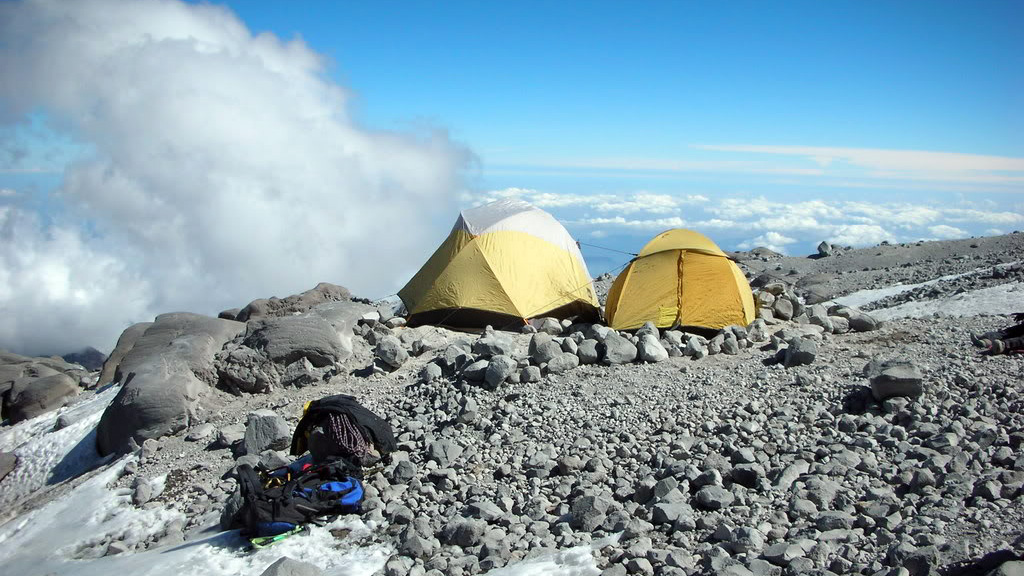
Tents near 16,500′. This area is what some parties use as their “high camp”.
We elected to set up our tent a few hundred feet from the huts in an effort to get a better sleep the second night. After setting up camp and relocating all of our gear, we sat down in the dirt next to the tent and admired the view. The flat plains of Mexico lay seven or eight thousand feet below us but we could not see them; a floor of clouds expanded outward beneath us, masking the underlying landscape. The sun set over the floor of clouds, painting them in a beautiful pink/orange coat. I took a few gulps of cold mountain water, effectively washing down the remnants of my tuna and dried tortilla dinner; Stu was busy reading The Brothers Karamazov.
After the sunset I crawled into the tent, Stu and I talked over some final preparations and considerations for the climb as we sipped on some hot tea, we were asleep shortly after.
Day 7: Summit Day
I awoke to the GPS alarm, the temperature in the tent was far below freezing. I roused Stu and fired up the Jetboil to make some hot tea.
“You ready for this?”
“Let’s just get going, I really want to summit this thing.”
I took a sip of tea and began putting on my winter gear. Thermal underwear. Insulating layers. More insulating layers. Gaiters. Balaclava. Soon I was much warmer than before, I stepped out of the tent and began packing my backpack. Jetboil. Fuel. Crampons. Extra clothes. Tuna. Stu emerged from the tent, even more bundled up than I (he gets cold much easier than I do).
“Let’s get the camp broken down real quick so we can hide our stuff”, he said.
We had agreed the night before that we were not going to take any chances with our gear. Thirty minutes later we began the ascent. Although it was very dark, we were easily able to retrace our steps through the moraines from the day before. In about an hour we worked our way up to the first snowfield and took a moment to strap on our crampons and melt snow.
Through the thin atmosphere at 16,000’, the stars were brilliant. We continued on through the crisp morning air and upon reaching our turn around point from the day before, a faint hint of light emanated from the east. I was about a hundred feet ahead of Stu when I came over the final ridge at the foot of the Jamapa Glacier. For the first time I was high enough to look over the cliff bands which had been blocking the view to the east. The sun rose over the horizon and illuminated the vast sea of clouds which were so far below. It was amazingly beautiful. I snapped a few pictures and Stu came up behind me.
“Where‘d you go?”
“I had to see this.”
“Let’s stay a little closer to each other from now on.”
“Yeah sorry about that.”
We took another break at the base of the glacier; Stu began chipping ice chunks out of the snow field for melting. The summit still seemed very far away; from where we were standing we could see two tiny black dots two thirds of the way up. Other climbers.
“That looks far”, I said.
“Yeah, let’s talk about the route we wanna take.”
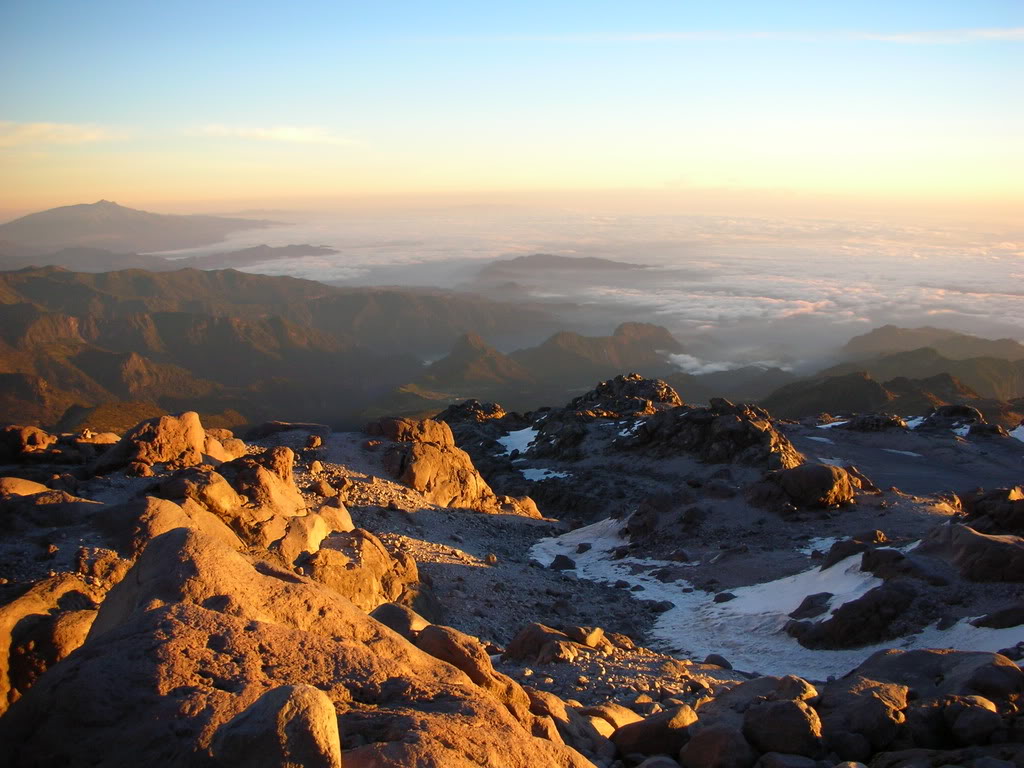
Looking back at the way we came from above the Labyrinth.
The Jamapa Glacier is essentially a massive snow and ice field which covers the top third of Orizaba (from 17,000’ to 18,400’). The slope gradually becomes steeper and maxes out at maybe 48 degrees near the summit.
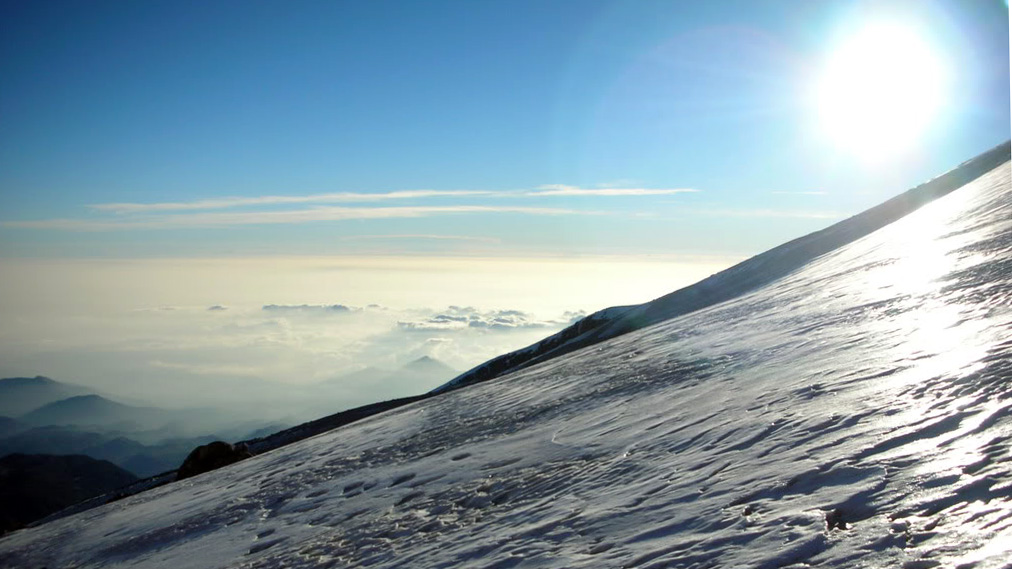
Jamapa sunrise.
After hydrating we decided to head straight up the glacier, ascending another five hundred feet in forty five minutes or so. We were now considerably higher than we had ever been before. Every ten steps or so required a thirty second break, I would often look back to see Stu doubled over his ice axe.
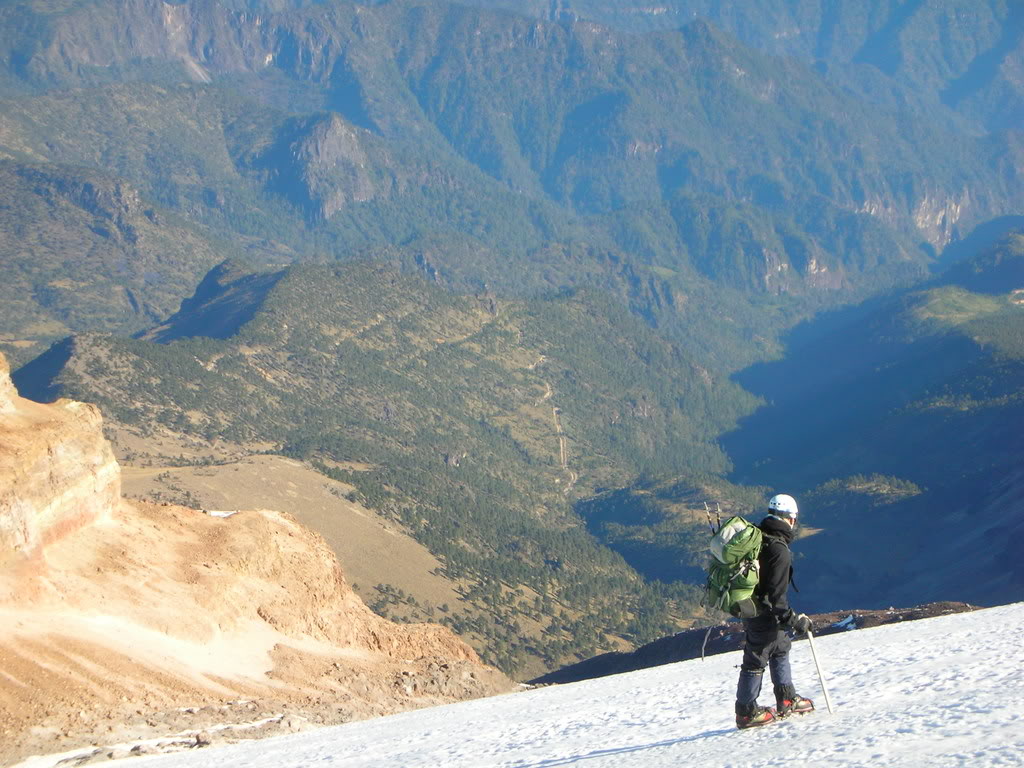
Green valleys far below.
At 18,000’ the slope reached its steepest point. I focused on being cautious not to stumble, I felt slightly light-headed and every now and then I would catch a crampon spike on my opposite foot. A fall here would have definitely been arrestable but I didn’t want to have to try. Another grueling hour and a half and we found ourselves on the summit ridge of Orizaba.
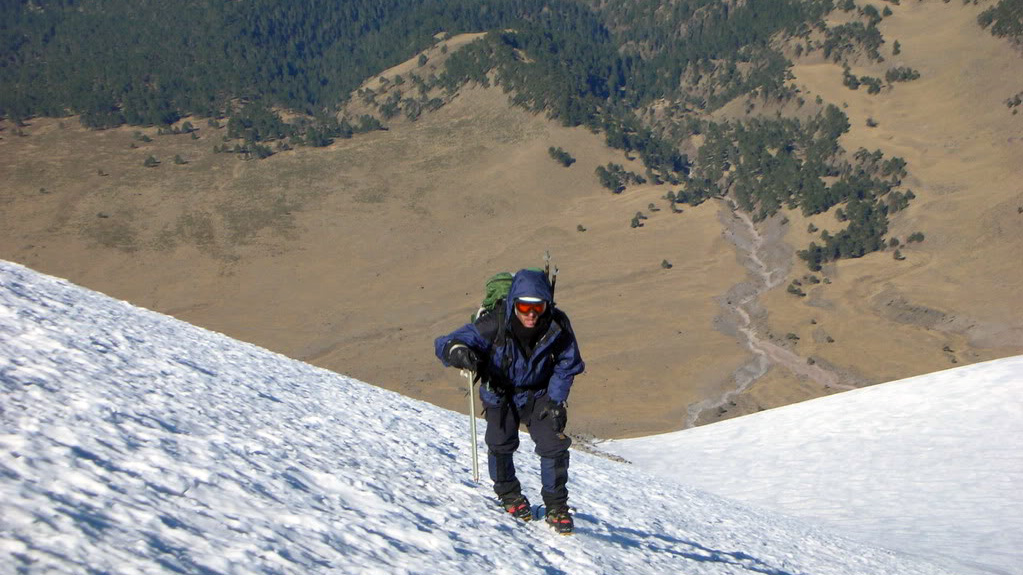
Closing in on the top.
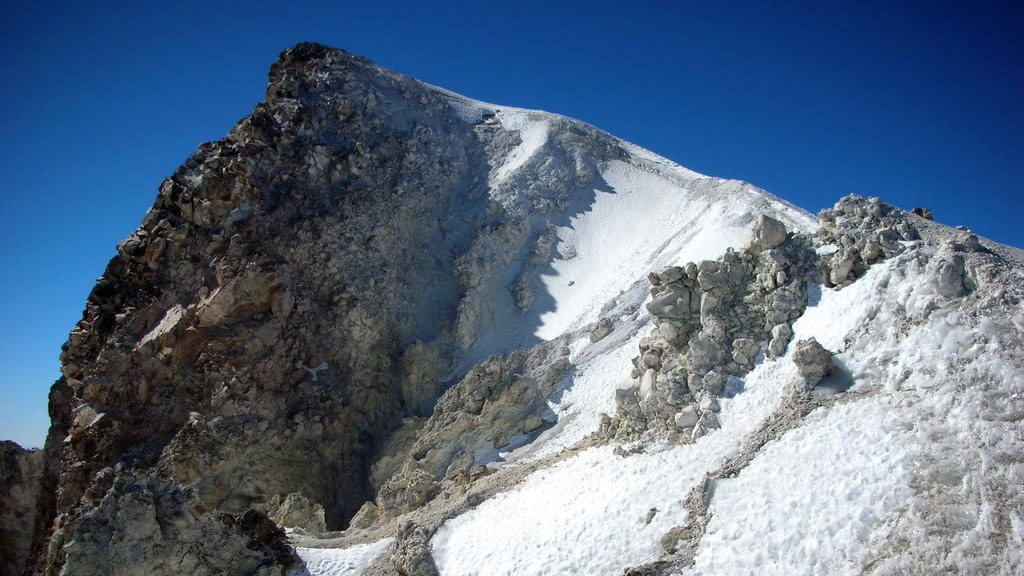
Orizaba’s craggy summit pinnacle.
Atop the glacier, the route curves around the outside of the volcanic crater to the west and ascends the final 150’. Fifteen minutes later, Stu and I stepped onto the third highest point in North America. Orizaba towers 11,000’ above the Mexican plains; it is the seventh most prominent mountain on Earth. We had a very powerful feeling of height while standing on top (as Secor promises). I snapped about a hundred photos and Stu broke out our celebratory Coca Cola. It was a great feeling to have conquered the altitude problem which plagued us three days earlier.
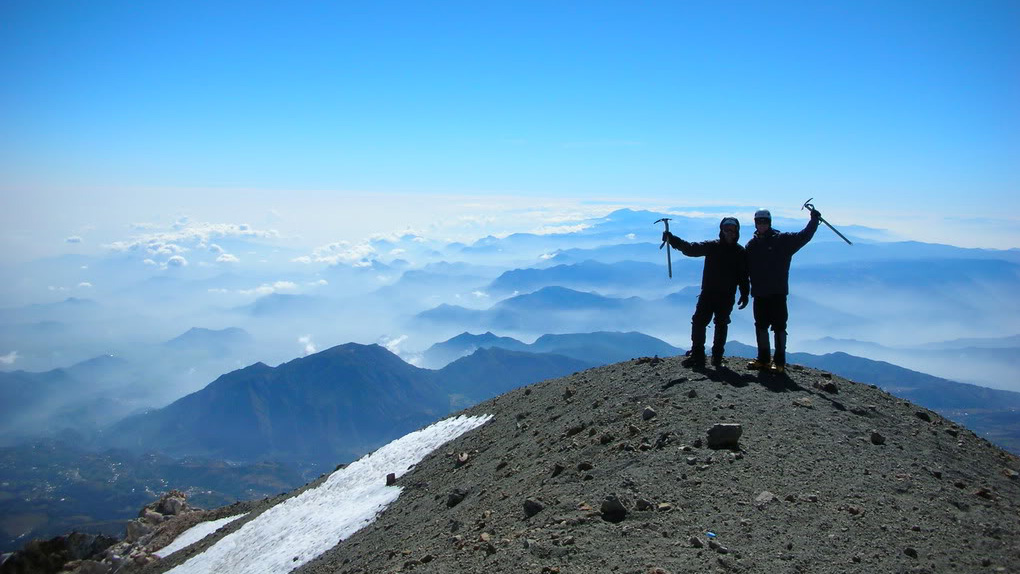
El Cumbre!
After thirty minutes on the summit we began the descent. We slogged down the glacier and reached the high camp in two hours. The clouds began to roll in again, enveloping the top section of the mountain as we passed under 16,000’. We reached Piedra Grande at 3:00pm, making the round trip in around eleven hours. Three hours later, Felipe’s son arrived in their family’s Jeep, loaded our gear for us, and congratulated us on a successful summit.
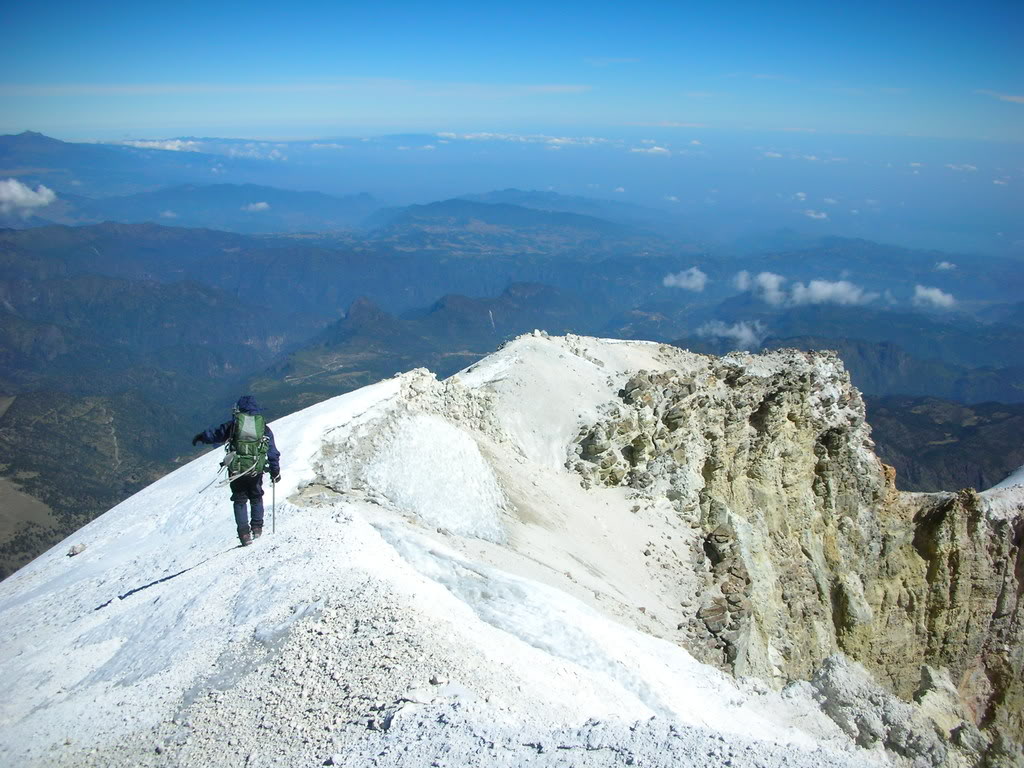
Strolling across the ridge.
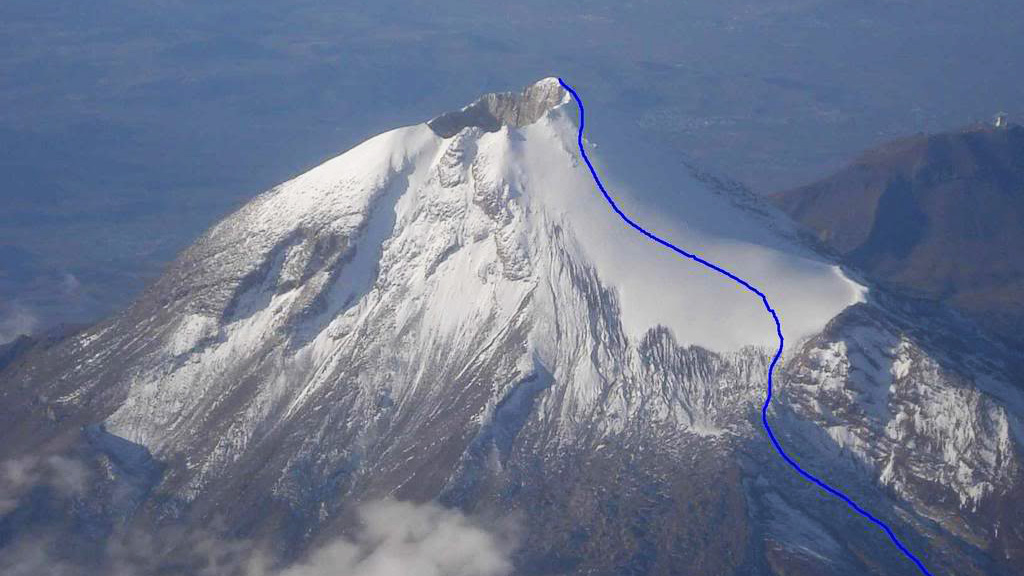
Overview of the route.
Overall this was a very enjoyable trip for us, but of course that is looking back 7 months after I‘m sure I‘ve forgotten most of the misery of it. A few pieces of advice which may save a few headaches:
1) I would have to say renting a car is the easiest option unless your only goal is Orizaba, the logistics that Stu and I faced trying to find transportation from Amecameca to Tlachichuca without a car were horrendous, it was a difficult trip and we certainly forked for it. However, if you‘re only going for Orizaba, there is a great bus system that operates between the Mexico City airport and Tlachichuca for around $30/person.
2) Within ten minutes of arriving in Tlachichuca, a dude had recognized we were climbers and won over our business. This town has a lot of options for finding gear, guides, lodging, and transportation to Piedra Grande. The only thing we could not find in Tlachichuca was pressurized gas canisters (for the Jetboil and our MSR stove). We lucked out as the guy who served us happened to have an extra from a previous expedition.
3) Take these things seriously! These mountains are LARGE, Stu and I tried to ascend Ixta with too little water, too little time at altitude, and barely any prior training (fat and lazy and no 14ers for 2 months) and suprise, we didn‘t make it. On Orizaba when we were taking acclimation seriously, we had no issues at all making it to the summit. I think this is a very big reason for the lower than necessary success rate on Orizaba, I‘m glad we learned our lesson on Ixta.
4) We brought harnesses, 5 ice screws, and a 60 meter rope and never used them, although I have heard of ice stopping people from summiting.
5) A number of teams got stormed off the glacier, even though the morning and early afternoon weather seems harmless, this is a huge mountain and it creates its own weather. Leave for the summit early!
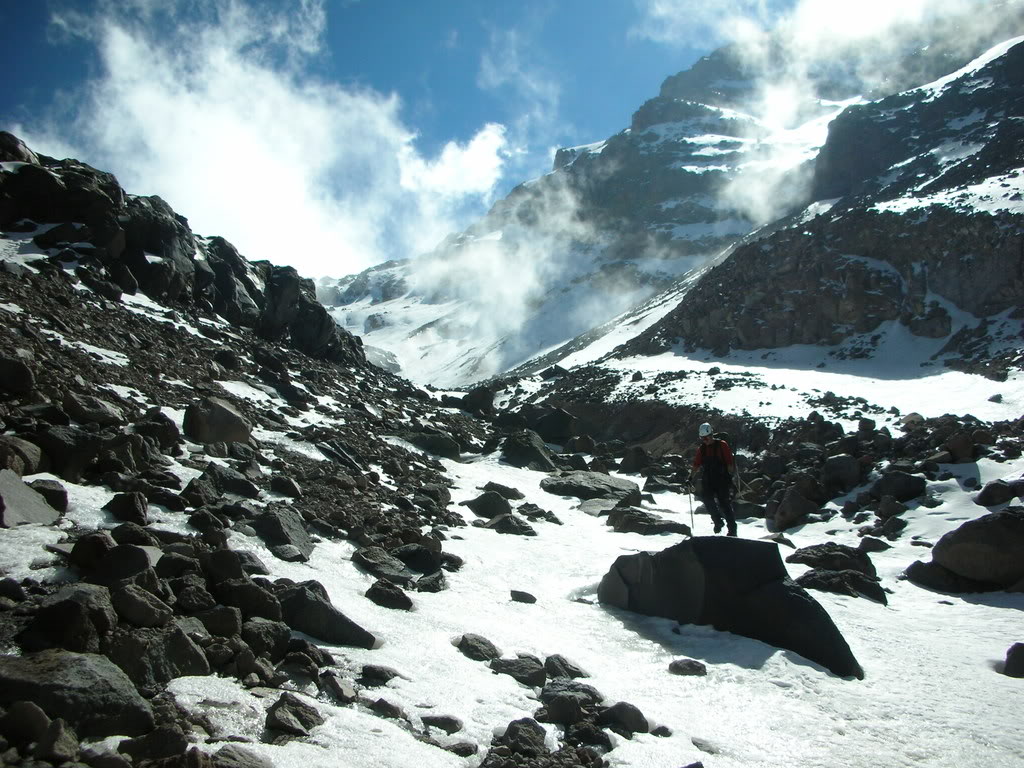
On descent.
